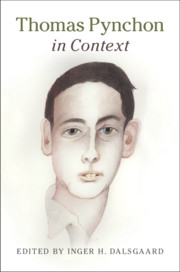Book contents
- Thomas Pynchon in Context
- Thomas Pynchon in Context
- Copyright page
- Contents
- Contributors
- Abbreviations
- Chronology
- Introduction
- Part I Times and Places
- Part II Culture, Politics, and Society
- Part III Approaches and Readings
- Chapter 34 Narratology
- Chapter 35 Genre
- Chapter 36 Postmodernism
- Chapter 37 Ambiguity
- Chapter 38 Realities
- Chapter 39 Material Readings
- Chapter 40 Digital Readings
- Chapter 41 Internet Resources
- Chapter 42 Fandom
- Chapter 43 Book Reviews and Reception
- Chapter 44 Critical Literature Review
- Further Reading
- Index
Chapter 34 - Narratology
from Part III - Approaches and Readings
Published online by Cambridge University Press: 31 May 2019
- Thomas Pynchon in Context
- Thomas Pynchon in Context
- Copyright page
- Contents
- Contributors
- Abbreviations
- Chronology
- Introduction
- Part I Times and Places
- Part II Culture, Politics, and Society
- Part III Approaches and Readings
- Chapter 34 Narratology
- Chapter 35 Genre
- Chapter 36 Postmodernism
- Chapter 37 Ambiguity
- Chapter 38 Realities
- Chapter 39 Material Readings
- Chapter 40 Digital Readings
- Chapter 41 Internet Resources
- Chapter 42 Fandom
- Chapter 43 Book Reviews and Reception
- Chapter 44 Critical Literature Review
- Further Reading
- Index
Summary
“Narratology” is a term coined by Tzvetan Todorov for the structuralist brand of narrative theory he and various Parisian colleagues started developing in the mid-1960s. “Classical narratology,” as it has now come to be called, primarily searched for narrative universals, but in the process it also provided critics with a handy toolkit for the study of any literary narrative. Thanks to the work of Gérard Genette, for instance, the concept of “focalization” now helps us to be precise when describing the (possibly varying) perspective on characters and events in a story. More recent work in “postclassical narratology” (a term proposed by David Herman in 1999) tries to overcome the flaws of its predecessor by paying attention “to the historicity and contextuality of modes of narrative representation as well as to its pragmatic function across various media, while research into narrative universals has been extended to cover narrative’s cognitive and epistemological functions.” As a result, the classical toolkit is also under scrutiny, but it does still keep the proliferation of new approaches to narrative together. If, for instance, the notion of the narrator has to be adjusted for the medium of film, that does not mean it simply goes out of the window.
- Type
- Chapter
- Information
- Thomas Pynchon in Context , pp. 273 - 280Publisher: Cambridge University PressPrint publication year: 2019

